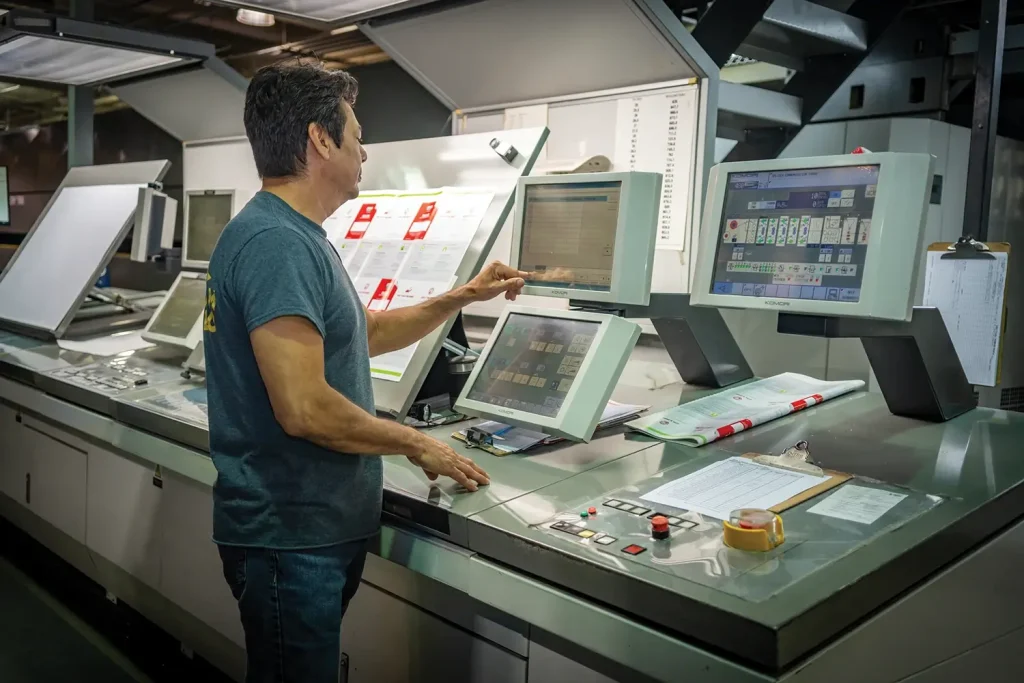In an industry shaped by evolving technologies and shifting market demands, staying ahead requires a keen understanding of both print and digital imaging. Fujifilm has long been at the forefront of innovation, delivering solutions that drive efficiency, quality, and sustainability. In this roundtable discussion, we bring together four industry leaders—Paul Albano, Sr. Product Manager for Toner Press Solutions; Greg Horney, National Sales Manager for Packaging; Greg Houser, Manager Digital Print Sales; and Michael Poulin, Sr. Product Manager for Inkjet Press Solutions—to explore the state of the industry, key trends shaping the future, and the innovations they’re most bullish on. From advancements in toner and inkjet to emerging opportunities in packaging, these experts share their perspectives on how Fujifilm is positioning itself to help print providers thrive in an increasingly digital world.
Where do you see the biggest opportunities for growth and innovation, particularly for progressive print companies looking to stay ahead of the curve?
Paul Albano: I’m bullish about the possibilities with digital printing and print-on-demand technology. Digital printing has seen huge leaps in quality, speed, and customization, with better automation, improved color accuracy, and the ability to print on a wider range of materials.
For example, Fujifilm’s latest Revoria Press Series enables printers to enter new markets with high-quality, versatile printing capabilities, especially in packaging, labels, and personalized print products. Embellishment capabilities and an expanded color gamut through our CMYK+ enabled products can add value to print by enhancing visual appeal and tactile experience. We feel that being at the forefront of these technologies is where progressive print companies can really set themselves apart.
Greg Houser: I agree with Paul. There is rarely a customer that my team speaks to that says, “Yeah, we are doing more with our traditional presses.” The opportunities are in the ability to be more creative and innovative, to stand out in the market all while being more efficient. Digital technologies are allowing this to happen.
“Digital quality and speeds have continually increased over the years piquing the interest of print companies looking to add digital solutions to their capability portfolio.”
– Greg Horney, National Sales Manager for Packaging
By using newer technology, printers and designers are creating some of the most unique and amazing output ever. Additionally, they can do it with less device interaction. The technology today can dramatically reduce total costs by reducing the labor required and errors creating wasted output.
Greg Horney: I agree. Plus, the digital market has been coming on strong on the flexographic stage. Digital quality and speeds have continually increased over the years piquing the interest of print companies looking to add digital solutions to their capability portfolio. Emerging companies looking to optimize shelf space availability and reduce packaging cost with flexible packaging is a growing market; however, these companies need affordable solutions to get products in this packaging style without meeting high MOQs for analog printed packaging. Cracking the wide web flexible packaging market is a critical next step to achieving short-run solutions for the printer at a price point that the product owner can manage.
Michael Poulin: Much of the U.S. digital print growth is centered around short-run, high-quality, and personalized printing. Companies wanting to stay ahead must be investing in high-speed, high-quality inkjet solutions like the Fujifilm J Press series. Beyond the traditional markets like general commercial work, publishing, and direct mail, inkjet presses are key to addressing the demand for shorter runs and faster turnaround in packaging.
With e-commerce exploding, the need for innovative packaging solutions is high. Digital inkjet solutions allow for more creative, branded, and functional packaging, which can be a major growth area.
Automation is another area where print providers can stand out. Integrating workflow automation with systems like Fujifilm’s XMF software boosts operational efficiency, keeping costs down.

What do you see as the biggest challenges facing progressive print companies today, and how can they strategically overcome these obstacles?
Paul Albano: In my opinion, the best strategy is to embrace innovation while remaining agile and customer focused. With the rise of digital media, print companies need to adapt by integrating digital platforms and variable data, offering personalized content.
To support sustainability demands, implementing eco-friendly practices is also crucial, so printers should focus on green initiatives like sustainable sourcing, implementing energy-efficient print technology, and using automation tools.
Greg Houser: I think the biggest challenge facing print companies today is their ability to accept that all this change has already started happening, and there will be more to come. We have seen many companies fold or get bought out by competition. It is very interesting because if you read market forecasts, there is talk of registering a CAGR of 4% to 7% depending on the source. The biggest challenge for some is to accept that doing business the same way they have been doing business in the past will not necessarily lead to success in the future.
Greg Horney: Consumer behavior is shifting to specialized products that drive the need for digital printing solutions to be profitable. The demand for sustainability is always present. Examples of ways to achieve sustainability is reduction in energy consumption and the use of LED over conventional UV or water wash plates versus conventional plating, leading to greater uptimes. Digital solutions also address the concern for sustainability by increasing uptimes, controls ink consumption, as well as reducing waste due to long make-ready times.
Michael Poulin: As more content moves online and jobs are more targeted and personalized, traditional print volumes are declining and becoming more complicated. This increasing demand for personalized products and shorter runs challenges print providers to remain flexible while maintaining high-quality output.
And I concur that as environmental regulations tighten and consumer demand for eco-friendly practices grows, print providers must implement sustainable solutions.
What do you see as Fujifilm’s role in helping printers elevate their businesses, differentiate themselves, and deliver greater value to their customers?
Paul Albano: Our wealth of market insights helps customers learn, anticipate, and adapt to industry trends, while uncovering new market opportunities. Printers partner with us as their “trusted advisor” in every aspect of their operations to enhance their capabilities, offer differentiated products, and deliver greater value to their customers.
Our Aspire series, as an example, helps graphic designers unleash their creativity by providing helpful techniques and collaboration with other designers in our network.
Greg Houser: Fujifilm’s history of quality and innovation in the print industry has been a hallmark in the industry. It is this core of who we are as a company that will continue to serve our customers.
With our digital toner products, we are leading the way with CMYK+ products. We are not only bringing the products to market, but we are also teaching the design community how to create for this technology. We are providing our partners with the tools to learn and share new capabilities with their customers. The goal is to inspire the printing community to grow and be creative.
Greg Horney: Fujifilm has long been involved in advancements in offset printing. Now Fujifilm is becoming well recognized in the flexographic stage with the advancement in our plating technology, LED/UV ink and curing systems, and digital solutions for packaging markets. Printers can be a one-stop shop for their existing customers as they expand product diversity.
“If the competition is adopting technologies that make them leaner, faster, and with better quality, your organization will fall behind and will not be able to keep up.”
– Greg Houser, Manager, Digital Print Sales
Michael Poulin: Fujifilm helps print providers elevate their business in many ways, including technological innovation. Advancements in inkjet printing technology provide printers with tools for high-quality, versatile printing, addressing many markets. The Paper Stabilizer on the J Press 1160 and its ability to print on coated papers without a primer is a great example of that innovation.
Fujifilm’s XMF platform is pretty cool. It allows companies to seamlessly integrate between prepress, press, and post press. This automation streamlines operations, reduces human error, and increases efficiency, helping businesses improve profitability.
What is your advice for print leaders to remain competitive, future-proof their operations, and maximize profitability in the years ahead?
Paul Albano: I think they need to embrace digital transformation by adopting cutting-edge print technologies and solutions for greater automation.
Automation streamlines production, reduces errors, increases efficiency, and lowers costs, making the print industry more competitive and allowing for quicker turnaround times. Additionally, automation can help mitigate challenges due to labor shortages by reducing the need for manual tasks, improving workflow efficiency, and enabling companies to maintain productivity with fewer skilled workers.
Greg Houser: The key will be to strategically adopt new technologies and digital transformation in a timely and efficient manner. Technology is moving as fast as ever. If the competition is adopting technologies that make them leaner, faster, and with better quality, your organization will fall behind and will not be able to keep up. We are starting to see this in the marketplace already, and those that are not adapting to the changes are getting left behind.
Greg Horney: Continue to understand customer needs and the direction of the market. Business leaders need to stay on top of technical advancements that can either improve their internal processes or better service their customers. In turn, they should continually audit their processes to ensure they stay optimized and address hidden factors within their own process.
Michael Poulin: Embrace digital inkjet technology. The future of printing is inkjet, and I believe the J Press series is the key to staying competitive. By investing in digital inkjet technology, print providers can take advantage of fast turnaround times, high-quality prints, and the ability to produce short runs and personalized jobs with ease, all with sustainable processes and low cost compared to other forms of print.
